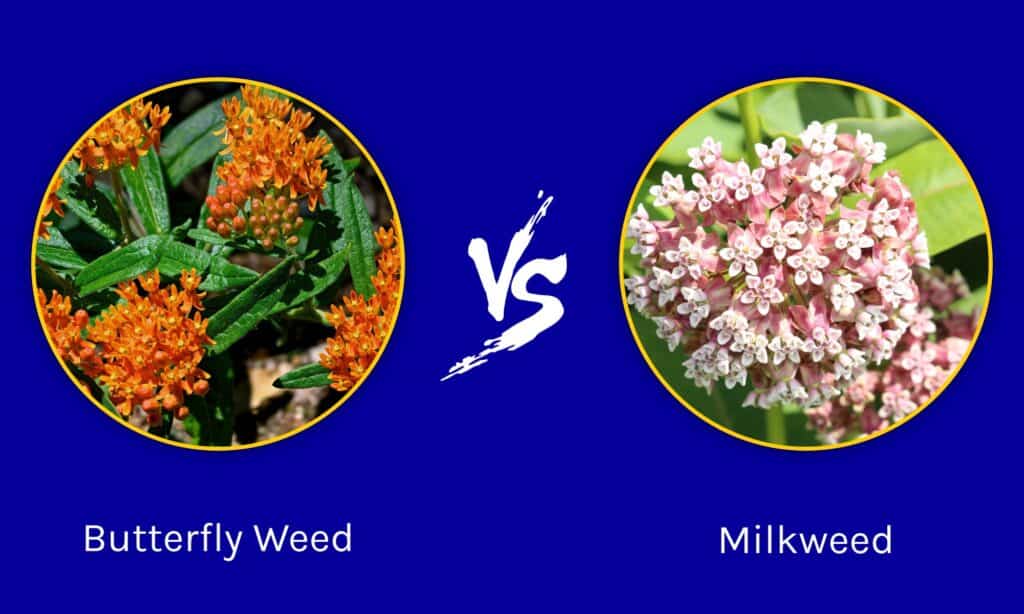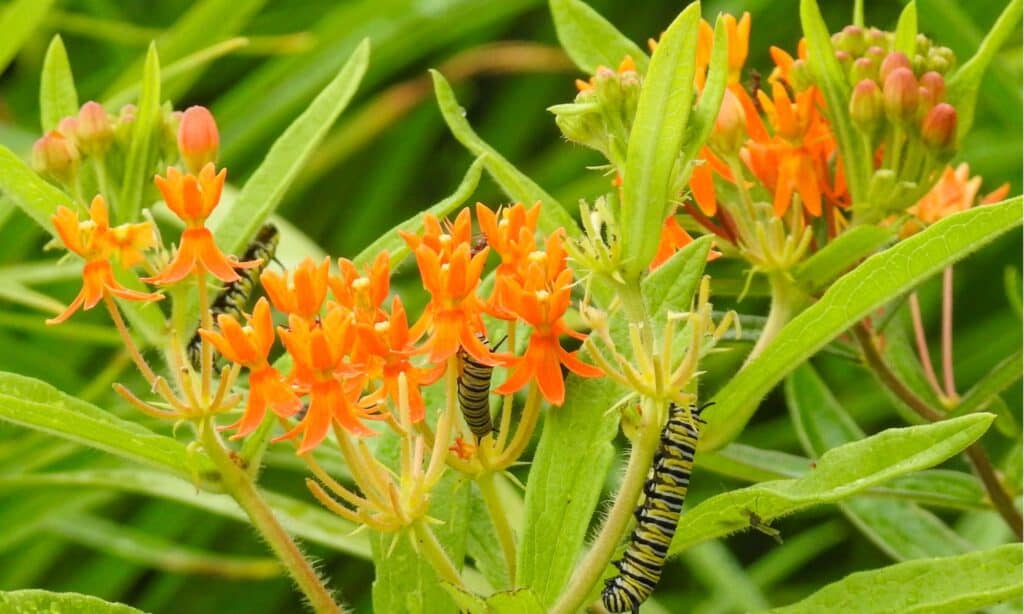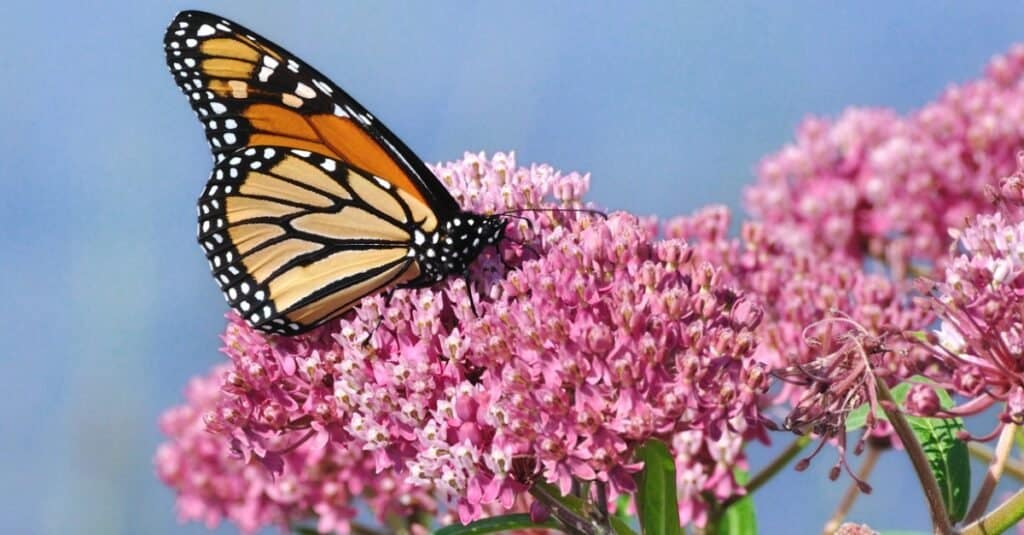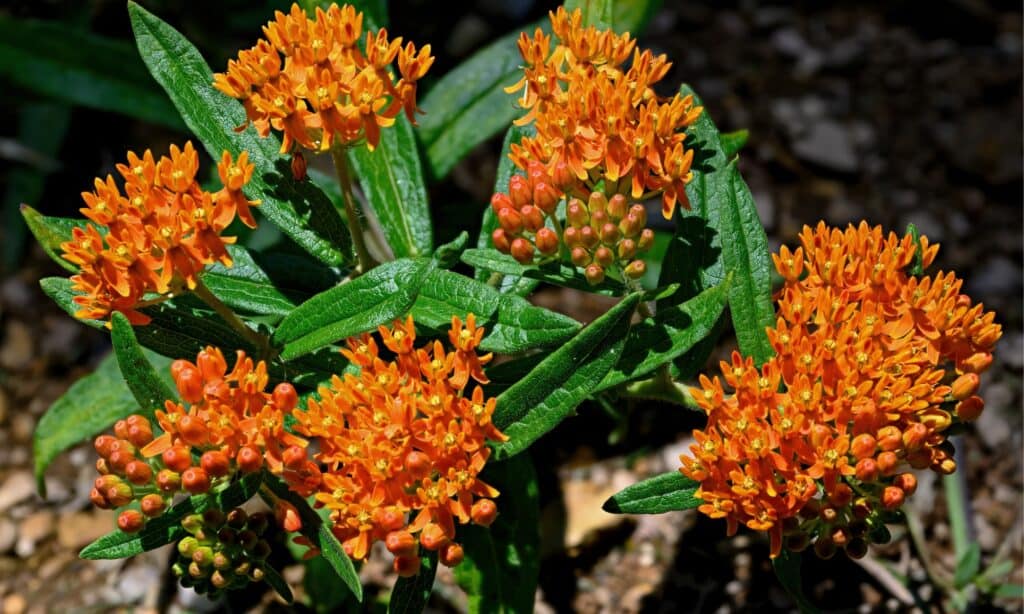If you are hoping to establish a flowering plant that attracts pollinators to your backyard garden, you may be wondering what the differences are between butterfly weed vs milkweed. These two plants are closely related to one another, but there are some key differences between them, including how they interact with various pollinators.
In this article, we will discuss all of the differences between butterfly weed and milkweed, including whether or not they are different species. We will go over what these plants look like physically as well as where they grow best in case you are interested in planting one for yourself. We’ll even go over other names for both of these plants, in case you are familiar with them already. Let’s get started now!
Comparing Butterfly Weed vs Milkweed

| Butterfly Weed | Milkweed | |
|---|---|---|
| Plant Classification | Asclepias tuberosa | Asclepias syriaca |
| Description | Reaches up to 4 feet tall with simple, deep green leaves and showy flowers. Flowers have five petals and can be found in yellow, orange, or red. Leaves are arranged opposite each other, while flowers bloom in large clusters | Reaches up to 6 feet tall with long, narrow leaves and clustered flowers. Flowers have five petals but are clustered together to form large umbel globes, typically in pink or purple hues. Leaves grow opposite each other, with some veining and a center line |
| Uses | Known as a primary food source for a variety of butterflies as moths but not good for reproductive purposes; also makes a great ornamental plant | Considered an invasive weed, but also a key food source for pollinators of all kinds; necessary for monarch butterflies and once provided plenty of food and shelter for them |
| Origin and Growing Preferences | Native to the eastern and southwestern US; prefers full sun and grainy or dry soil | Native to Canada and the eastern US; prefers moist soil but can handle some drought conditions |
| Other Names | Orange milkweed, Indian paintbrush, chiggerflower, white-root, butterfly milkweed | Silkweed, common milkweed, butterfly flower, swallow-wort |
Key Differences Between Butterfly Weed vs Milkweed

The average milkweed plant grows taller than the average butterfly weed.
©iStock.com/Catherine Egger
There are a number of key differences between butterfly weed and milkweed. For example, the average milkweed plant grows taller than the average butterfly weed. Most common milkweed plants have pink or purple flowers, while butterfly weed plants have orange, yellow, or red flowers. When it comes to attracting pollinators, both of these plants do a good job, but butterfly weed is not ideal for monarch butterfly reproduction, while milkweed is.
Let’s go over all of these differences in more detail.
Butterfly Weed vs Milkweed: Classification
Both belonging to the Asclepias or milkweed genus, there are some undeniable similarities between butterfly weed and common milkweed. One could even argue that all butterfly weed is technically milkweed, but not all milkweed is butterfly weed. Common milkweed is classified as Asclepias syriaca, while butterfly weed is classified as Asclepias tuberosa, making them both distinct and unique species from one another.
Butterfly Weed vs Milkweed: Description

Milkweed flowers come in shades of purple or pink and rarely white, while butterfly weed flowers come in shades of yellow, orange, and red.
©iStock.com/herreid
Despite their relation to each other and they’re colloquial confusion, there are some physical differences between butterfly weed and common milkweed. For example, the average milkweed plant reaches up to six feet in height, while butterfly weed only reaches four feet tall. The leaves on both of these plants grow opposite each other and are fairly simplistic, but milkweed leaves have a distinct line down the center, while butterfly weed leaves do not.
One of the main differences between these two plants is how their flowers grow. To begin with, milkweed flowers come in shades of purple or pink and rarely white, while butterfly weed flowers come in shades of yellow, orange, and red. In addition, butterfly weed flowers grow in close clusters, while milkweed flowers form large, globed umbels atop the ends of each stem. While it may not be obvious at first, milkweed blooms grow closer together compared to butterfly weed blooms.
Butterfly Weed vs Milkweed: Uses

The average butterfly weed attracts more butterflies than milkweed, as milkweed is preferred by other types of pollinators.
©iStock.com/McKinneMike
Butterfly weed and milkweed have similar uses to one another. For example, they both provide plenty of nectar for pollinators. Butterfly weed attracts more butterflies than milkweed; milkweed is preferred by other types of pollinators. However, the monarch butterfly enjoys milkweed for both nutrition and shelter, while butterfly weed is typically not preferred by the monarch butterfly. In fact, studies suggest that the monarch butterfly population has declined in direct relation to the decline of various milkweed fields across the United States.
Butterfly Weed vs Milkweed: Origin and How to Grow
Milkweed and butterfly weed originated in North America, but there are some subtle differences in how they grow best. For example, milkweed is native to Canada and the Eastern United States, while butterfly weed is native to the eastern and Southwestern parts of the United States.
Both of these plants thrive in full sunlight and a variety of conditions, but milkweed prefers more water and higher moisture levels overall when compared with butterfly weed. Either option is easily grown in a backyard garden. However, milkweed is invasive and butterfly weed is not.
Butterfly Weed vs Milkweed: Other Names

Either option is easily grown in a backyard garden, but milkweed is invasive and butterfly weed is not.
©iStock.com/mr_coffee
One of the many reasons why butterfly weed and milkweed are confused for one another lies in their names. They are often named interchangeably even though they belong to very different species. You may know butterfly weed as orange milkweed, Indian paintbrush, chiggerflower, white-root, or butterfly milkweed. However, you may know milkweed as silkweed, common milkweed, butterfly flower, or swallow-wort.
Bonus: Could Planting Milkweed Help the Monarch Butterflies Escape Extinction?

Flocks of migrating monarch butterflies were once a common sight.
©Dotted Yeti/Shutterstock.com
If you are of a certain age you probably remember finding a butterfly chrysalis attached to a shrub, putting it in a jar, and watching it emerge as a bright orange and black butterfly. After it got its bearings and dried its brand new wings – so delicately beautiful they seemed to have been painted by tiny fairies – you set it free to flutter into the summer air.
What was once a right of summer for children is now almost extinct – as the IUCN listed the migratory monarch butterfly as endangered in July 2022. Just 30 years ago, hundreds of millions of monarchs were recorded at overwintering sights annually; today, that number has fallen below 80 million.
Monarchs have been following milkweed – the only plant on which their eggs can be laid – around the world for tens of thousands of years. Around 20,000 years ago, monarchs began following milkweed southward – as receding glaciers and a warmer climate allowed milkweed to colonize new lands.

It is exciting to watch the chrysalis of a monarch butterfly develop and emerge.
©Barbara Ash/Shutterstock.com
In the Americas, the monarchs leave their overwintering sites in the Sierra Madre mountains of Michoacan and Mexico to travel to Texas and Oklahoma to lay eggs on milkweed before the end of their lifespan. These eggs hatch and undergo their complete metamorphosis before traveling hundreds of miles across the U. S. and Canada. A fourth generation develops in the northernmost part of the monarchs range – the great-grandchildren of the butterflies that overwintered in Mexico. That group begins life in Maine before retracing the entire journey back to Mexico – stopping to lay eggs on milkweed along the way.
The distribution of native milkweed species has been drastically affected by the use of pesticides and herbicides, habitat loss due to agriculture, logging, and urbanization, and by fires, storms, droughts, and invasive species associated with climate change. You can do your part to revive the plant and the butterfly by planting milkweed in a sunny spot on your property. It can easily form the backdrop of a sunny garden and will attract a variety of pollinators in addition to the monarch butterflies. Perhaps the milkweed bushes you plant will enable your children or grandchildren to experience the wonder of the monarch butterfly’s metamorphosis – sparking dreams of beauty, transformation and heaven.
The photo featured at the top of this post is © iStock.com/McKinneMike
Sources
- FLOWER COLOR AND ENVIRONMENT: THE CASE OF BUTTERFLY WEED IN OKLAHOMA, Available here: https://www.tandfonline.com/doi/abs/10.1111/j.0033-0124.1977.00374.x?journalCode=rtpg20
- Monarch waystations: Propagating Native Plants to Create Travel Corridors for Migrating Monarch Butterflies, Available here: http://npj.uwpress.org/content/15/1/5.short
- Milkweed loss in agricultural fields because of herbicide use: effect on the monarch butterfly population, Available here: https://resjournals.onlinelibrary.wiley.com/doi/abs/10.1111/j.1752-4598.2012.00196.x
Thank you for reading! Have some feedback for us? Contact the AZ Animals editorial team.






